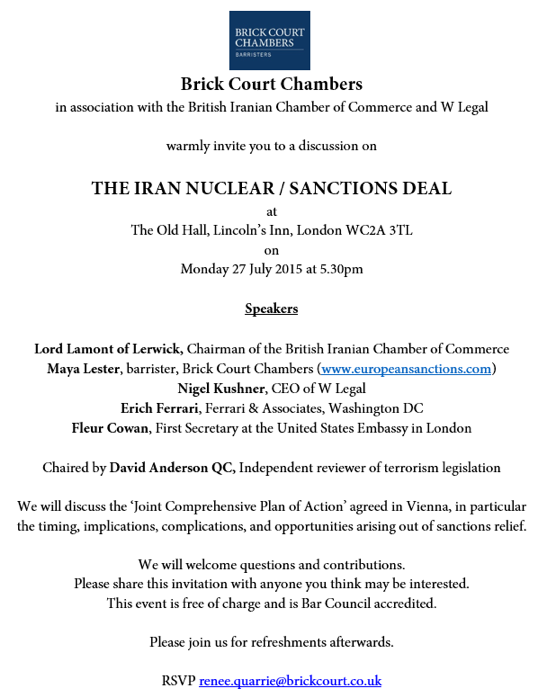Treasury Designates al-Qaida Members Located in Iran
Last week, the United States Department of the Treasury announced the designation of three senior al-Qaida members located in Iran – Faisal Jassim Mohammed al-Amri al-Khalidi, Yisra Muhammad Ibrahim Bayumi, and Abu Bakr Muhammad Ghumayn – for acting for or on behalf of al-Qaida. Each of the designations was made under the authority of Executive Order 13224 (E.O. 13224), which mandates that all property and interests in property held within the U.S. or within the possession or control of a U.S. person be blocked and prohibits U.S. persons from transacting with the designees.
Treasury’s allegations are as follows:
- Faisal Jassim Mohammad al-Amri al-Khalidi is alleged to be a senior al-Qaida official and “part of a new generation of al-Qaida operatives.” According to Treasury’s press release, al-Khalidi “was responsible for liasing between al-Qaida associates and al-Qaida Central Shura members and leaders within the U.S.-designated terrorist group Tehrik-e Taliban Pakistan.”
- Yisra Muhammad Ibrahim Bayumi is alleged to be a “veteran al-Qaida member” who was “involved in freeing al-Qaida members in Iran” and “facilitating al-Qaida funds transfers.”
- Abu Bakr Muhammad Muhammad Ghumayn is alleged to “control the financing and organization of al-Qaida members located in Iran.” Previously, Ghuyman had served al-Qaida in an “intelligence and security capacity.”
Most news coverage of the designations, however, has focused less on the designated individuals and their alleged activities and more on the fact that the three senior al-Qaida members are alleged to be located in Iran. That in itself is an event because common wisdom suggests that al-Qaida is ideologically hostile to Iran, the population of which is predominantly Shia Muslim and thus viewed by al-Qaida and its supporters as apostates. Following news of the Treasury designations, though, some ran with the allegations to claim tacit ongoing cooperation between Iran and al-Qaida.
Yet Treasury’s press release itself tells us little about such cooperation. In fact, as described above, there is implicit recognition that Iranian authorities have cracked down on al-Qaida members based in Iran: Bayumi is alleged to have “free[d] al-Qaida members in Iran” and served as mediator with Iranian authorities. Establishing such a connection between al-Qaida and Iran through Treasury’s press release requires a big conjecture from limited set of facts.
Meanwhile, Iran’s Foreign Ministry was quick to dismiss the U.S. claims, asking the U.S. to provide intelligence cooperation should it believe that al-Qaida personnel are located in Iran. Even the Obama administration itself suggested that claims of Iran-Qaida cooperation are “baseless conspiracy theories,” as while al-Qaida “has long used Iran as a transit and facilitation point between South Asia and the Middle East…the Iranian government has imprisoned some al-Qaida operatives.” The U.S. official noted that Treasury’s action was designed to “provide [Iran] another opportunity…to take action against al-Qaida.”
Nonetheless, this is not the first time Treasury has used language implying a connection between Iran and al-Qaida, suggesting a divide between different parts of the U.S. intelligence community. Several past Treasury designation notices, for instance, have also carried allegations suggesting that Iran has, at the very least, tolerated al-Qaida’s presence within its own borders:
- In June 2008, the Treasury Department designated ‘Abd al-Rahman Muhammad Jaffar ‘Ali, an al-Qaida financier and facilitator, and Adil Muhammad Mahmud Abd al-Khaliq, an al-Qaida operative. ‘Ali was alleged to be responsible for the movement of funds to a senior al-Qaida facilitator based in Iran. Al-Khaliq was alleged to have “traveled to Iran five times on behalf of al-Qaida…[and to have] met with senior al-Qaida facilitators during each of these trips.”
- In January 2009, the Treasury Department designated four al-Qaida associates based in Iran. This included Mustafa Hamid, a senior al-Qaida associate, who was alleged to serve as a “primary interlocutor between al-Qaida and the Government of Iran.” Hamid, the U.S. Department of the Treasury alleged, “was harbored by the Islamic Revolutionary Guard Corps (IRGC), which served as Hamid’s point of contact for communications between al-Qaida and Iran.” The designation notice contained other details of al-Qaida and Iran’s “marriage of convenience,” according to U.S. Director of National Intelligence James Clapper.
- In July 2011, the Treasury Department designated six members of an al-Qaida network that had been operating under an agreement between al-Qaida and Iranian authorities. According to the press notice, Iran was a “critical transit point for funding to support al-Qaida’s activities in Afghanistan and Pakistan,” and this specific network “serve[d] as a the core pipeline through which al-Qaida moves money, facilitators and operatives from across the Middle East to South Asia…” In very aggressive wording, then-Under Secretary for Terrorism and Financial Intelligence David S. Cohen alleged that Iran – as “the leading state sponsor of terrorism in the world” – was being “expos[ed] [for] its secret deal with al-Qaida allowing it to funnel funds and operatives through its territory.”
- In February 2012, the Treasury Department designated Iran’s Ministry of Intelligence and Security (MOIS) under the authorities of Executive Orders 13324, 13553, and 13572. According to Treasury’s press notice, the MOIS was responsible for “facilitat[ing] the movement of al-Qaida operatives in Iran and provid[ing] them with documents, identification cards, and passports.” The MOIS was also alleged to have “provided money and weapons to al-Qaida in Iran…”
- In February 2014, the Treasury Department designated “a key Iran-based al-Qa’ida facilitator who supports al-Qa’ida’s vital facilitation network in Iran.” The designated al-Qa’ida facilitator – Olimzhon Adkhamovich Sadikov – had “operate[d] [in Iran] with the knowledge of Iranian authorities,” using “Iran as a transit point for moving funding and foreign fighters through Turkey to support al-Qa’ida-affiliated elements in Syria, including the al-Nusrah Front.”
If it is the case, then, that the Obama administration views suggestions of Iran-Qaida cooperation as “baseless conspiracy theories” — the relationship, if any, going no further than the mere presence of al-Qaida operatives in the less-governed areas in southeast Iran — then what explains the much more aggressive posturing of the Treasury Department?




1 Comments
In answer to your last question (ok, so it’s rhetorical), it must surely be the different vested interests within the U.S. foreign policy and intelligence community engaging in rivalry over how to respond to JCPOA and how/whether to engage with Iran. What is given with one hand is taken with the other, though not by the same persons.
Comments are closed.